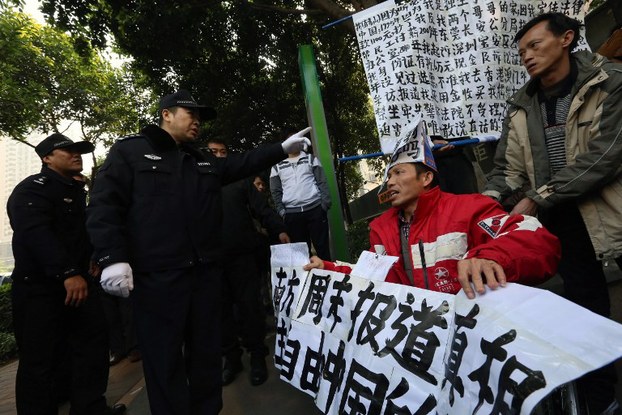




China is increasingly extending its controls over the media beyond the country’s borders to restrict sensitive news abroad, a new report said Tuesday.
A “China factor” in global newsrooms is influencing foreign media and overseas Chinese news outlets against running stories that portray the country in an unfavorable light, either through overt pressure by Chinese officials or through subtle methods that induce self-censorship, the report published by the U.S.-based National Endowment for Democracy said.
“The dynamics are subtle, but the reality is that the ‘China Factor’ exists in newsrooms around the world, be they internationally renowned outlets such as the New York Times and Bloomberg, a local newspaper in Nepal, or a Chinese radio station in Los Angeles,” said Sarah Cook, a research analyst with media watchdog Freedom House and author of the report.
“The Chinese government’s efforts to influence reporting by foreign and overseas Chinese news outlets have intensified and expanded over the past five years.”
Chinese officials have impeded independent reporting by media based abroad, the report said, by banning correspondents from sites of important incidents or pressuring media executives not to publish content deemed politically undesirable to the ruling Chinese Communist Party (CCP).
More frequently, and more effectively, the party employs methods of control that “subtly induce self-censorship” among media owners and outlets, the report said, through proxies including advertisers, satellite firms, and foreign governments.
“These international actors have boycotted disfavored outlets, cut transmission signals, or arrested activists disseminating news critical of the Chinese Communist Party,” the report said.
'Hot button' issues
Often, the information targeted by the party for censorship includes stories pertaining to human rights abuses, high-level corruption, and environmental pollution, as well as “hot button” issues such as the persecution of Tibetans, Uyghurs, and Falun Gong practitioners or commentaries critical of one-party rule.
The report focused on the effect of the “China factor” on major international media; local outlets in Asia, Africa, and Latin America; mainstream media in Hong Kong and Taiwan; exile Chinese outlets and media serving Chinese diaspora communities around the world.
In addition to the news media, the phenomenon was also commonly found to affect the film, literature, and performing arts industries.
Information gathered for the report “suggest[s] a systematic effort to signal to commercial partners and media owners that their operations in China and access to Chinese citizens will be jeopardized if they assist, do business with, or refrain from censoring voices the Chinese Communist Party has designated as politically undesirable,” it said.
Various measures
Chinese authorities employ physical attacks, visa restrictions, and website blocks to obstruct journalists from the international media and retaliate against news companies for critical reports, the report said, adding that cyberattacks have expanded from targeting individuals to the global servers of news outlets.
Chinese officials have made use of “especially forceful measures” to obstruct media outlets run by critical Chinese expatriates, it said, and in some cases have co-opted foreign companies and event organizers into hampering reporting and content dissemination.
Local international governments, mostly in Asia, have taken steps to restrict or punish local reporting critical of China at the behest of Beijing or to avoid tension with the region’s most influential donor and trading partner, while in Africa and Latin America, Chinese government-linked entities with stakes in local media push to promote Beijing’s view.
In Hong Kong, Taiwan, and Chinese diaspora communities, Beijing has largely worked to marginalize critical reporting by co-opting owners of media outlets, influencing newsroom decisions and promoting self-censorship, the report said.
Pushback
But despite the wide-ranging and influential nature of this pressure, journalists, activists, owners, and independent courts outside of Chinese have “pushed back” and “scored some important victories,” leading to a “complex, nuanced, and ever-changing negotiation over where the ‘red line’ lies,” the report said.
It called on democratic governments and international donors to offer diplomatic support, professional training, funding for further research and direct financial assistance to assist news outlets and journalists struggling with the challenges of China’s strong new push for media control.
Media outlets should be transparent about pressures and other infringements coming from China, it said.
“Much is at stake in this global contest between the Chinese government’s power and media freedom,” Cook said.
“China is too important a country for the world not to be fully aware of what is happening on the ground and for Chinese people to lose vital sources of independent information and commentary.”